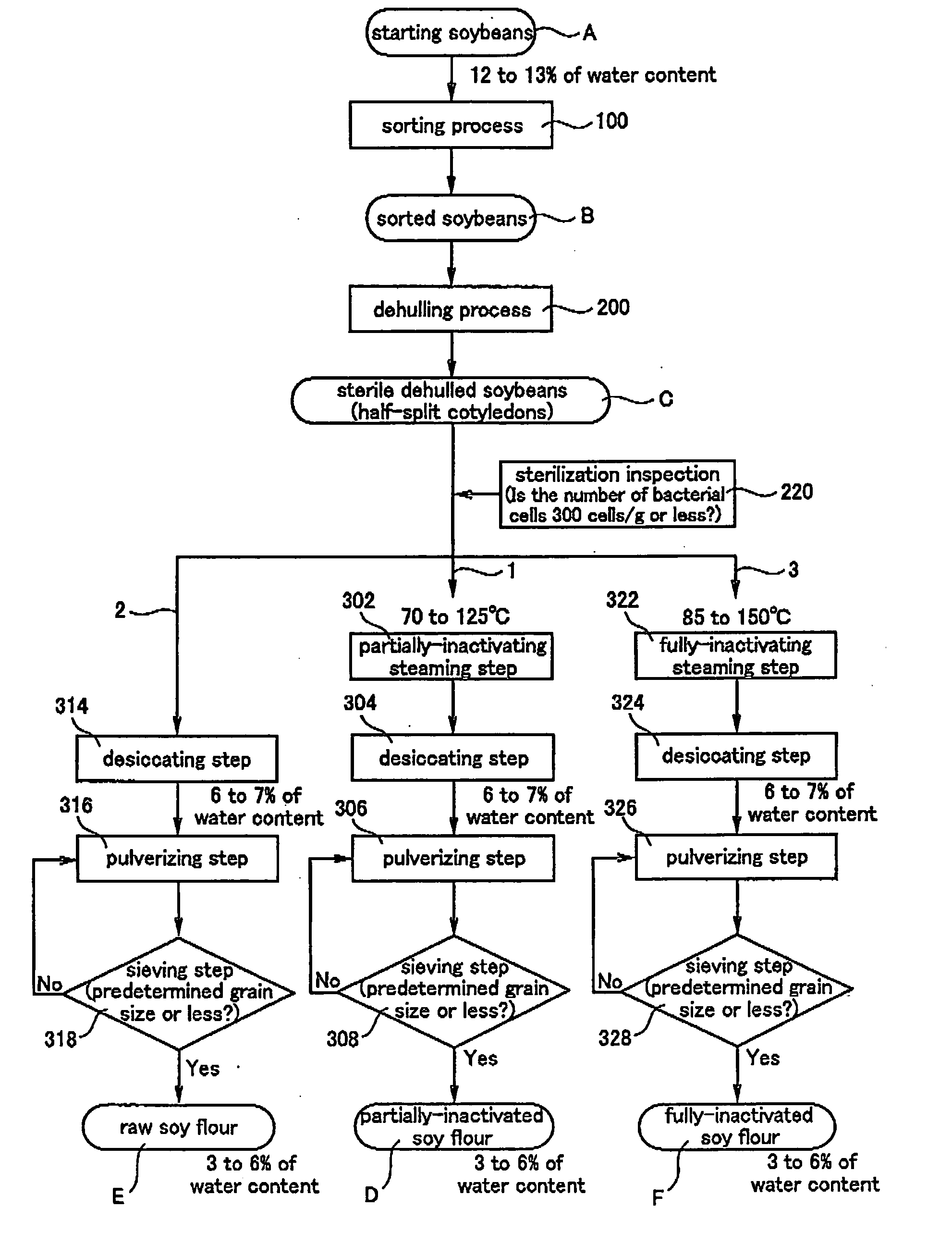Sterile dehulled soybean and method for producing sterile full fat soy flour
a soybean and sterile technology, applied in the field of sterile dehulled soybeans and methods for producing sterile full fat soy flour, can solve the problems of insufficient sterilization, difficult to be digested and absorbed, and difficult to produce sterile soybeans bearing 300 cells/g or less
- Summary
- Abstract
- Description
- Claims
- Application Information
AI Technical Summary
Benefits of technology
Problems solved by technology
Method used
Image
Examples
example 1
[0067] First, the sorting step 100 was conducted in the following manner to obtain sorted soybeans (B) from starting soybeans (A).
[0068] From 100 kg of the starting soybeans (A), foreign matters larger than soybeans (corn, mud mass and the like) or foreign matters smaller than soybeans (grass seeds, morning glory seeds) were removed by means of a commercially available rough sorting machine (rough sorting step 102), light foreign matters (dirt, skin, small dust and the like) were removed by means of a commercially available gravity separator (air sorting step 104), foreign matters that are heavier than soybeans such as stones were removed by means of a commercially available stone removing machine (stone removing step 106), foreign matters having different shapes were removed by means of a commercially available roller sorting machine (roller sorting step 108), and the resultant soybeans were sorted according to the grain size by means of a commercially available grain size sorting...
example 2
[0085] The raw soy flour (E) was obtained in a similar manner as Example 1 except that a step corresponding to the partially-inactivating steaming step 302 was not conducted. Componential analysis similar to that of Example 1 revealed that trypsin inhibitor which is a digestion inhibiting enzyme was not inactivated, and denaturation of available ingredients (nutrition composition) possessed by soybeans was little observed. Bacteria inspection revealed that the numbers of different bacteria were 300 cells / g or less, and no harmful substance such as residual pesticide was detected as is the same with Example 1.
[0086] Bean curd produced by using the full fat raw soy flours (E) of Example 2 was very delicious and kept for a long time.
example 3
[0087] The fully-inactivated soy flour (F) was obtained in a similar manner as Example 1 except that in place of the partially-inactivating steaming step 302, the sterile dehulled soybeans (C) were subjected to steaming by steam of 125° C. for 90 seconds using a commercially available steaming furnace (fully-inactivating steaming step 322). Componential analysis similar to that of Example 1 revealed that available ingredients (nutrition composition) were denatured to some degree, and all enzymes were inactivated. Bacteria inspection revealed that the numbers of different bacteria were 300 cells / g or less, and no harmful substance such as residual pesticide was detected, as is the same with Example 1.
[0088] The full fat fully-inactivated soy flour (F) is fully inactivated and deodorized, and hence the soybean is easy to handle, and can be utilized in various processed foods, and processed foods thereof kept for a long time.
PUM
 Login to View More
Login to View More Abstract
Description
Claims
Application Information
 Login to View More
Login to View More - R&D
- Intellectual Property
- Life Sciences
- Materials
- Tech Scout
- Unparalleled Data Quality
- Higher Quality Content
- 60% Fewer Hallucinations
Browse by: Latest US Patents, China's latest patents, Technical Efficacy Thesaurus, Application Domain, Technology Topic, Popular Technical Reports.
© 2025 PatSnap. All rights reserved.Legal|Privacy policy|Modern Slavery Act Transparency Statement|Sitemap|About US| Contact US: help@patsnap.com



